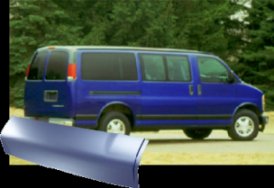|
|
|
|
|
|
|
|
|
|
Solvay companies use special polymers to produce front and rear spoilers and bumper elements that can resist high temperatures. These give excellent grip to paint, and can therefore be painted the same color as the body. The bumpers can also be made of injected PP, while polypropylene foams serve as energy absorbers under the bumpers. Suspension-system vibration absorbers are made of polyurethane elastomers, manufactured with caprolactone. Polyarylamide or PPS resins have proven ideal for door handles and technical parts of rear-view mirrors. Used as a protective layer, Polyvinylidene Fluoride (PVDF) gives thermoformed parts exceptional gloss and high resistance to scratching. Caprolactones are also used as to improve flexibility, toughness and light stability in resins for paints.
|
|
|
|
|
|
|
|
|
|
|
|
|
|
|
The GE Plastics products within The Weatherables portfolio include GELOY®, LEXAN®, XENOY®, and VALOX® resins. These resins meet the rigorous requirements of a wide variety of outdoor, end product applications that need to maintain their primary performance and property characteristics when exposed to a broad array of environmental conditions. The Weatherables portfolio has been tapped for vital roles in automobiles, roofing, siding, windows, exterior electronic-equipment housings, and other applications once dominated by wood and metal. Not only do the resins offer cost savings and processing advantages over their conventional counterparts, but they also offer enhanced mechanical properties, including: color retention under severe environmental conditions; resistance to chipping, pitting, chalking, rusting and hazing; and resistance to degradation caused by visible and ultraviolet light. Many of the resins exhibit strong low- temperature impact properties, as well as resistance to chemical and biological attack. In the automotive industry, for example, OEMs often specify GELOY resin for a spectrum of exterior components, such as cowl vent and radiator grilles, headlight bezels, and mirror housings. GELOY automotive-grade resins feature heat and impact resistance, color retention, and low thermal expansion properties. The injection-moldable resin is available in molded-in black and gray, making it more efficient and environmentally friendly by eliminating the need for costly painting processes. Reducing paint can also result in a reduction of emissions of volatile organic compounds. |
|
|
XENOY resin is a versatile thermoplastic alloy blend of polybutylene terephthalate (PBT) and polycarbonate (PC). This product family offers good chemical resistance, great impact resistance even at low temperatures, heat resistance, outstanding aesthetics and flow characteristics. Certain resins offer very good UV resistance and color retention. The result? Cost-efficiency, improved productivity and higher yields in applications ranging from thin-wall automotive bumpers and body panels to housings for business equipment, lawn mower decks and cellular phones. Xenoy resins offer:
|
|
|
|
|
|
NORYL GTX® resin can help provide automotive OEMs with a solution to global demands for lighter cars with exterior parts that resist impact and corrosion. NORYL GTX resin is an advanced blend of polyphenylene oxide and polyamide resins engineered to combine high heat resistance for E-coat paint requirements with very good chemical resistance, mechanical performance and dimensional stability. The principal advantage of NORYL GTX resin over traditional materials is a good cost/weight performance ratio. NORYL GTX resin can bring weight reductions of 40 to 60% versus steel panels, with sufficient modulus to meet the same stringent OEM and car-owner impact requirements. NORYL GTX resin also delivers advantages over SMC materials, such as lower mass, faster cycle times, improved paintability, impact strength and recyclability. The design of body panel systems in engineering thermoplastics helps achieve desired weight reductions. Body panel designs made from NORYL GTX resin can help eliminate intricate bracketry that is a requirement in steel systems. High flow properties of engineering thermoplastics enable processors to mold-in intricate attachments and help eliminate costly secondary operations and subassembly steps. The exterior parts are removed from the tool with a Class A surface, and no secondary sanding is required. Body panels made from NORYL GTX resin currently can be painted in E-coat ovens at temperatures from 350 to 375°F, and may approach the 400°F mark with future advances. Advanced conductive grades of NORYL GTX resin help save money by eliminating expensive primers and enhancing paint transfer efficiency when using electrostatic painting. From a design perspective, NORYL GTX resin gives automakers the flexibility to achieve desired styling differentiation. Engineering thermoplastics have lower tooling cost requirements than steel, and therefore more frequent styling updates are an affordable option. Recycling and design cascading is a year 2000 initiative and global trend in the automotive industry that emphasizes the use of engineering thermoplastics. When paint is removed, NORYL GTX resin can be post-consumer recycled, a critical requirement to meet global recycle objectives. Design cascading already is becoming cost effective using NORYL GTX resin, allowing scrap from one part to be ground and re-used in another part for the same vehicle. Forward-looking programs such as this one can help OEMs manage the waste stream in automotive manufacturing and meet growing global regulations for recycling. NORYL GTX resin can deliver a competitive advantage when it comes to exterior automotive applications. A combination of mechanical and chemical properties offers OEMs a cost-effective alternative to traditional metals and other non-ferrous materials for body panels. Enhanced system recyclability and low production-run tooling cost make body panels made from NORYL GTX resin a cost-effective exterior system solution for automotive OEMs. |
|
|
|



